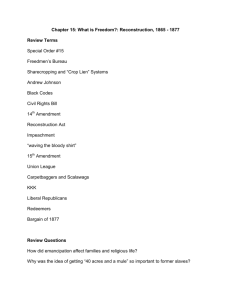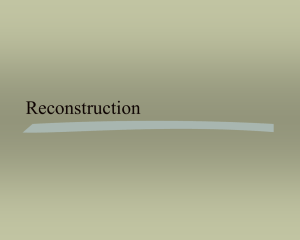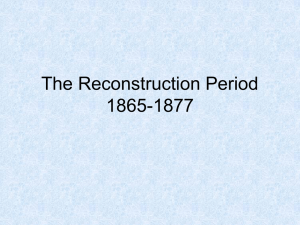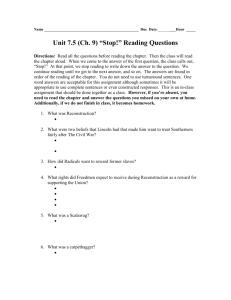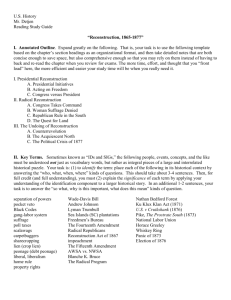Document
advertisement
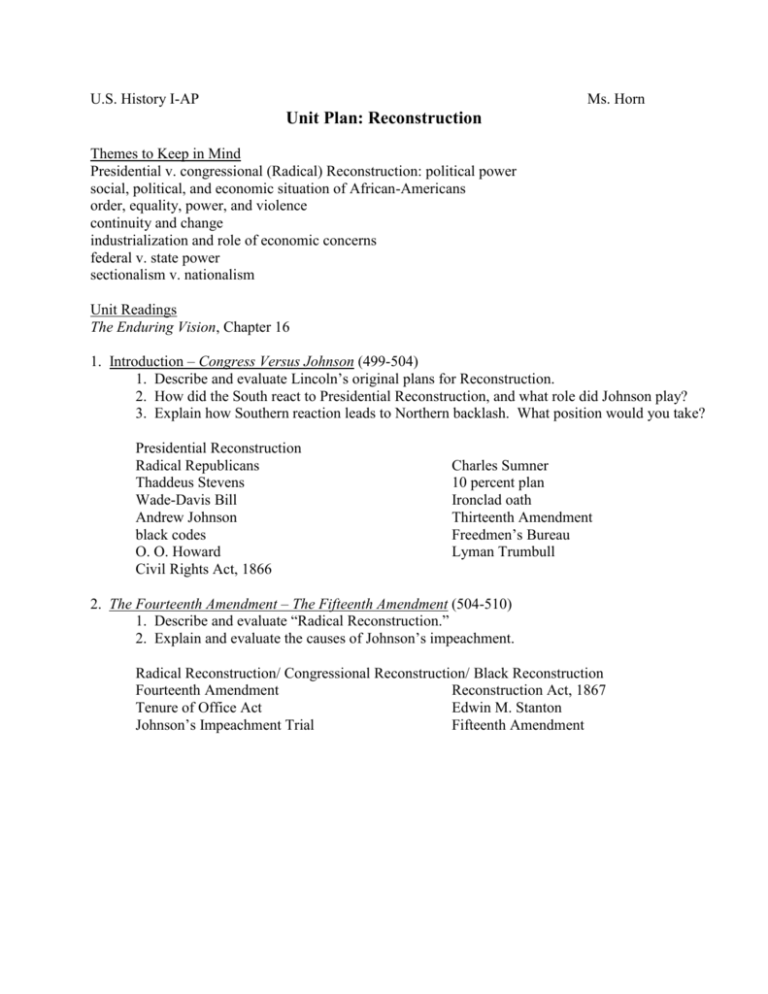
U.S. History I-AP Ms. Horn Unit Plan: Reconstruction Themes to Keep in Mind Presidential v. congressional (Radical) Reconstruction: political power social, political, and economic situation of African-Americans order, equality, power, and violence continuity and change industrialization and role of economic concerns federal v. state power sectionalism v. nationalism Unit Readings The Enduring Vision, Chapter 16 1. Introduction – Congress Versus Johnson (499-504) 1. Describe and evaluate Lincoln’s original plans for Reconstruction. 2. How did the South react to Presidential Reconstruction, and what role did Johnson play? 3. Explain how Southern reaction leads to Northern backlash. What position would you take? Presidential Reconstruction Radical Republicans Thaddeus Stevens Wade-Davis Bill Andrew Johnson black codes O. O. Howard Civil Rights Act, 1866 Charles Sumner 10 percent plan Ironclad oath Thirteenth Amendment Freedmen’s Bureau Lyman Trumbull 2. The Fourteenth Amendment – The Fifteenth Amendment (504-510) 1. Describe and evaluate “Radical Reconstruction.” 2. Explain and evaluate the causes of Johnson’s impeachment. Radical Reconstruction/ Congressional Reconstruction/ Black Reconstruction Fourteenth Amendment Reconstruction Act, 1867 Tenure of Office Act Edwin M. Stanton Johnson’s Impeachment Trial Fifteenth Amendment 3. Reconstruction Governments – Republican Rule (510-513) AND The Impact of Emancipation – Black Institutions (515-518) 1. What steps were taken by the government and by individuals to help the freedmen? 2. In what was, and to what degree were freedmen able to take advantage of their new opportunities? carpetbaggers freedmen Blanche K. Bruce Civil Rights Act, 1875 scalawags Hiram Revels Southern Homestead Act 4. Counterattacks (513-515), A Place in Time (519a-b), Land, Labor and Sharecropping – Toward a Crop-Lien Economy (518-521) 1. What steps did white southerners take to prevent blacks from taking advantage of their freedom? Why? How successful were they? 2. How did sharecropping work to help both freed men and white landowners? To what degree, and for whom was it successful? In what ways was it flawed? Note the different desires of freedmen and landowners. 3. How did the combination of the KKK and sharecropping impact the lives of freedmen? Knights of the White Camelia Nathan Bedford Forrest Ulysses S. Grant sharecropping/ tenant farming Ku Klux Klan Enforcement Acts (KKK Act) Amnesty Act Crop-liens 5. New Concerns in the North – Republicans in Retreat (521-526) 1. What events are taking place in the North that distract many from the issue of Reconstruction? 2. How do the Panic of 1873 and the post Civil War era change the economic structure of the U.S.? 3. What role do the courts play in Reconstruction? To what degree to the further or hinder the cause of freedmen? Election 1868: Grant, Seymour Jay Gould/ Jim Fisk Orville Babcock/ whiskey ring Grantism William H. Seward/ Seward’s folly Horace Greeley Jay Cooke free-silver Greenback Party Slaughterhouse Cases U.S. v. Cruikshank sound money v. easy money Credit Mobilier William E. Belknap Boss Tweed/ Tammany Hall Santo Domingo Panic of 1873 Public Credit Act Bland-Allison Act Texas v. White (1869) U.S. v. Reese 6. Reconstruction Abandoned – Conclusion (526-531) 1. In the end, to what degree, and for whom, was Reconstruction successful? 2. Why did Reconstruction end as it did? Redeemers/ Redemption Home rule Kansas exodus Election of 1876 Rutherford B. Hayes Samuel B. Tilden Compromise of 1877 Plessy v. Ferguson (1896)


